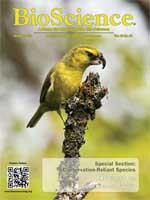Rusty Russell, program manager for collections and informatics in the department of botany at the National Museum of Natural History, Smithsonian Institution, has a problem that frustrates many science collections managers. His museum holds a wealth of archival materials, yet much of it is inaccessible. When he is contacted by a researcher who wants a specific field notebook, for example, Russell sends someone to search the department's shelves for the requested item. But, he observed, “Nobody knows where everything is.”
A series of recent projects, funded and unfunded, will make publicly available on the Web the contents of natural history museums' archives, including annotated field notebooks, with related content linked. For example, the late American Museum of Natural History (AMNH) president, Henry Fairfield Osborn, would be linked to his son, the president of the New York Zoological Society; Osborn's uncle, J. P. Morgan; the expeditions he supported; and specimens he deposited in natural history museums.
Those involved in archiving projects shared ideas at the annual meeting of the Society for the Preservation of Natural History Collections (usually called SPNHC, pronounced like “spinach”), hosted by Yale University in New Haven, Connecticut, in June. The meeting, said Jessica Utrup of the Yale Peabody Museum's archiving project, is “a crucial crucible for museum folk,” giving them an opportunity to find related projects and learn from each other.
Among the attendees was Russell, who has been considering for years an idea that would let his department “get a list of what we've got and share it more aggressively with other organizations and see what they've got.” Thus began The Field Book Project, funded by the nonprofit Council on Library and Information Resources (CLIR), the Smithsonian Women's Committee, and the National Trust for Historic Preservation, in partnership with the Biodiversity Heritage Library, the New York Botanical Garden, the California Academy of Sciences, Harvard's Herbarium and Museum of Comparative Zoology, and the Missouri Botanical Garden. At the Smithsonian, the archiving project began in Russell's department and is slowly moving into others. By late June, nearly 6000 field notebooks were archived (see http://mnh.si.edu/rc/fieldbooks and http:// nmnh.typepad.com/fieldbooks).
AMNH archivist Barbara Mathé explained that an archival collection on a single person or expedition may contain 100 linear feet of boxes. “To describe what's in those boxes, there needs to be a finding aid that lists the contents of the boxes and folders. The finding aid also describes the context of the collection in biographical and historical notes. Terms used in the catalog record and the finding aid are written using a controlled vocabulary for the form of a name, traditionally called '‘authorities’ by librarians,” Mathé explained in an email. “When these terms are linked, the relationships between them lead to discoveries about other collections on what is called the semantic web,” she continued. Mathé explained that all you need are three pieces of semantic data to create links from one person or concept to others—subject, predicate, object; for example, Henry Fairfield Osborn was related to (was the nephew of) J. P. Morgan.
With no financial resources and little free time, but with much interest, creativity, and 13 already transcribed field notebooks from malacologist Junius Henderson, the founder of the University of Colorado Museum of Natural History; Rob Guralnick, invertebrate curator of zoology; and Andrea Thomer, a PhD student in library and information science at the University of Illinois at Urbana-Champaign, began putting Henderson's annotated field notebooks online. They were fortunate that a retired curator at Colorado had transcribed the notebooks and saved each one as a separate document. They also found scans of the field notes. “We used Wikisource templates to create an annotation mechanism and asked volunteers on the Internet to help us annotate species names, locations, and dates,” wrote Guralnick in an e-mail. They produced approximately 1100 annotated records for three field notebooks over a twomonth period, he said. Annotation, Guralnick explained, “calls out” certain text in standardized syntax (http://soyouthinkyoucandigitize.wordpress.com/ 2011/11/28/an-ode-to-founders-and-afield-notes-challenge-part-1).
Tim White, director of collections at the Peabody, which is involved in another CLIR-funded project, explained, “Capturing information about museums' archival holdings will aid biographers and scientists in bridging the gap between the collector's insights, biodiversity, and [the] history of science.”
Describing and annotating the archive contents of natural history museums is a massive undertaking. AMNH has an estimated 25,000 linear feet of archives, for example. In invertebrate paleontology at the Peabody, "We probably have at least 80 linear feet of just locality documents, field notes, and maps—and that's just 1 of 12 divisions,” Utrup said. “We don't have the time, money, [or] people,” even with a 3-year CLIR grant shared among various projects.
Adds Russell of the Smithsonian, “The enormous scale of this is pretty clear.”





